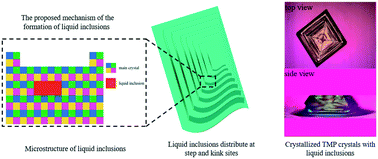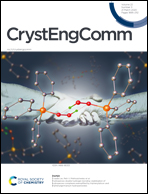Effect of crystal growth kinetics on the formation of liquid inclusions in tetramethylpyrazine crystals†
Abstract
Crystal purity is of primary importance for pharmaceutical crystallization, and the inclusion of mother liquids inside the crystals poses a great challenge and threat to the product quality and purification efficiency. It is well recognized in industry that mother liquids can be included inside the crystals; however, the underlying formation mechanism remains poorly understood. Herein, we investigated the formation of liquid inclusions during crystallization of a model compound tetramethylpyrazine (TMP), which is a bioactive alkaloid drug, with an aim to better understand and hence control the liquid inclusions formed inside the crystals. The formation of mother liquid inclusions inside TMP crystals was fully characterized by optical polarizing microscopy, micro-Raman spectroscopy, and powder X-ray diffraction. Three types of fluid inclusions were observed in TMP crystals, and the single-phase liquid inclusions dominate. The effects of initial supersaturation and temperature on the formation of liquid inclusions were studied both qualitatively and quantitatively by optical microscopy and gas chromatography. It was found that high supersaturation and high temperature were favorable to the mother liquid inclusions in the resultant crystals. Moreover, the amounts of liquid inclusions inside the crystals are positively correlated with the growth rate of the TMP crystals. Solvent effects on the formation of liquid inclusions were also studied by choosing four types of solvents of distinct polarity. The results showed the solvent dependence of the formation of liquid inclusions, and the TMP crystals harvested from ethyl acetate displayed the most remarkable inclusions of mother liquids while the fewest liquid inclusions were found in isopropanol. Furthermore, the inclusion amounts of mother liquids can be correlated with the growth rates in different solvents but could not simply be correlated with only one type of property of the four solvents such as polarity, viscosity, dielectric constant, or surface tension. Finally, the inclusion of mother liquids inside TMP crystals was suggested to be effectively suppressed by crystallization at lower temperature and supersaturation, as well as in solvents with greater polarity and viscosity.



 Please wait while we load your content...
Please wait while we load your content...